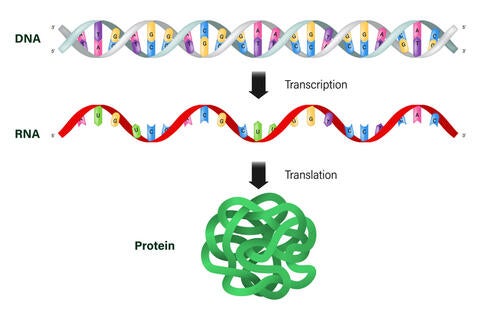
Huntington’s disease causes involuntary movements and dementia, has no cure, and is fatal. For the first time, UC Riverside scientists have shown they can slow its progression in flies and worms, opening the door to human treatments.
Key to understanding these advancements is the way that genetic information in cells is converted from DNA into RNA, and then into proteins. DNA is composed of chemicals called nucleotides: adenine (A), thymine (T), guanine (G), and cytosine (C). The order of these nucleotides determines what biological instructions are contained in a strand of DNA.
On occasion, some DNA nucleotides repeat themselves, expanding the DNA strand. In Huntington’s disease, this expansion occurs with three nucleotides, cytosine-adenine-guanine, or CAG.
Expansion into an extraordinary number of repeated CAG sequences of DNA is associated with earlier onset and increased severity of Huntington’s disease symptoms. Similar observations were made for a number of other neurodegenerative diseases.
When these DNA repeats are translated into RNA, there is an insidious side effect. The cell chemically modifies the extra RNA buildup. Wang and his collaborators learned that the modified RNA plays a crucial role in neurodegeneration.
“We are first to discover that a type of chemical modification, called methylation, occurs more frequently with extra repeats in RNA. Then we see abnormal distribution and buildup of a particular protein in cells,” said Yinsheng Wang, distinguished UCR professor of chemistry. “In other words, methylation converts an important cellular protein into waste.”
These findings parallel observations made for the same protein in brain tissues of Huntington’s disease, ALS and frontotemporal dementia patients. Longer RNA repeats mean a higher modification rate, which generates more protein waste and exacerbates disease.
“Even healthy people have up to 34 CAG repeats on a particular gene, the HTT gene,” Wang said. “However, due to environmental or genetic causes, there might be as many as 100 CAG repeats in the cells of people with Huntington’s disease.”
Long, repetitive RNA sequences can turn into an excess of protein in cells, creating “cellular trash,” which has toxic effects.
A new Nature journal article details how RNA methylation on CAG repeats is implicated in the complex mechanism underlying Huntington’s disease. The article also explains how the researchers greatly reduced the progression of disease in worms and fruit flies and extended the lifespan of flies by introducing a protein into cells that removes methylation.
At present there is no way to cure or even slow the progression of Huntington disease. Health care providers typically offer medications to help with some symptoms. While this breakthrough is not a cure, it represents the possibility of an effective therapy where none currently exists.
The research team, which includes professors Weifeng Gu at UCR, X. William Yang at UCLA and Nancy M. Bonini at the University of Pennsylvania, is now searching for small molecules that can inhibit methylation and form the basis of a Huntington’s therapy.
Because RNA repeats are present in similar diseases, like ALS and certain types of spinocerebellar ataxia, the door is open to treatments for these other fatal, degenerative diseases.
“We don’t think the mechanisms we studied are the only ones that contribute to Huntington’s,” Wang said. “However, we have shown that by targeting them we can reduce the disease in model organisms, which could lead to longer, better lives for those who suffer from this and potentially other diseases as well.”
(Cover image: Shidlovski/iStock/Getty)




